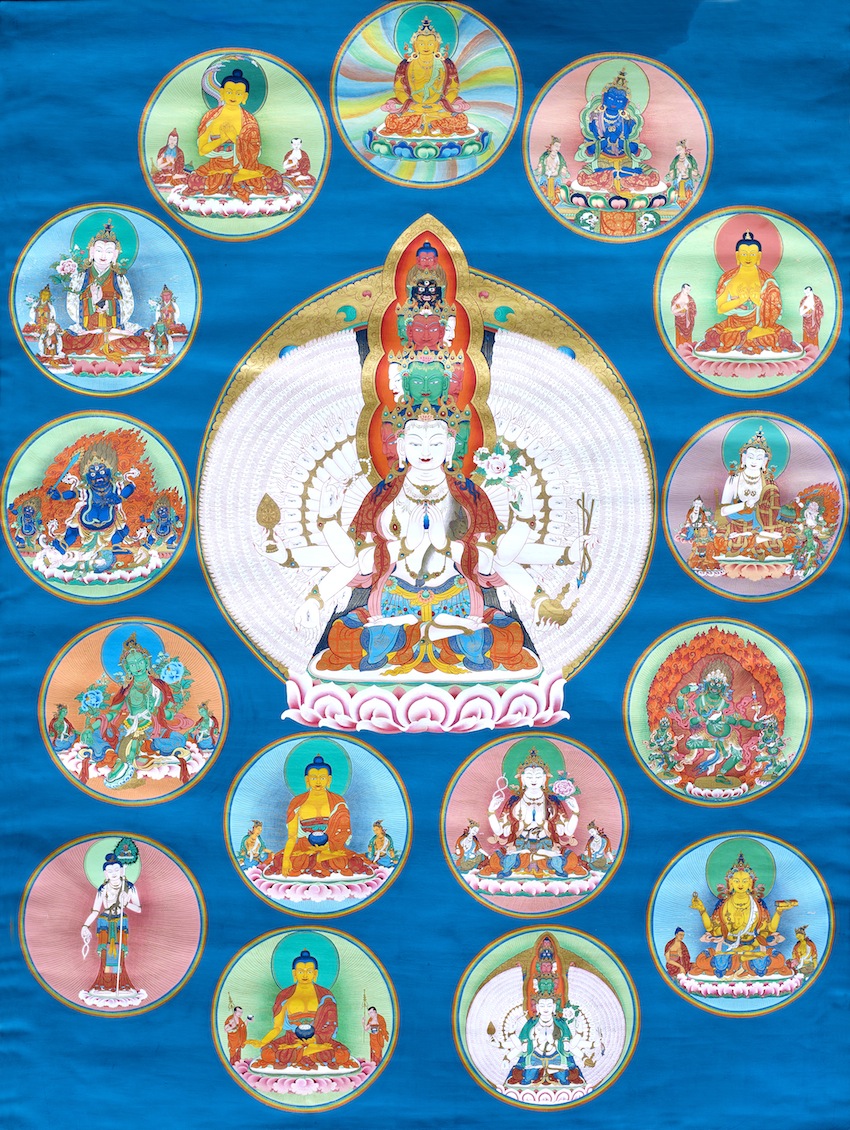16 Drops of Kadam Initiation
At the conclusion of the 2015 Jangchup Lamrim Teachings, His Holiness the Dalai Lama kindly bestowed the Sixteen Drops of Kadam Initiation. Materials related to this initiation can be found below.
Introductory Information
The following excerpt is from the Introduction to The Book of Kadam: The Core Texts, translated by Geshe Thubten Jinpa, which contains more information on the 16 Drops of Kadam Initiation. The Book of Kadam is available from Wisdom Publications here.
In chapter 2 [of The Book of Kadam], Atiśa then specifies his preferred divinities in the context of the second recollection—recalling one’s body as divinities—and makes the well-known selection of Buddha, Acala, Avalokiteśvara, and Tārā as the four gods of Kadam. At one point in the text, in the course of conversations between Atiśa and Dromtönpa on the four divinities, Dromtönpa’s heart opens up and miraculously reveals progressively the entire realm of the Buddha Śākyamuni, the realm of Avalokiteśvara, the realm of Tārā, and finally the realm of Acala. It is here that we also find explicit mention of Avalokiteśvara’s famous six-syllable mantra, oṃ maṇi padme hūṃ.
This deity yoga, in its developed form, came to be referred to as the practice of the sixteen drops, which is explained in some detail in Khenchen Nyima Gyaltsen’s Elucidation of the Heart-Drop Practice (entry IV in part 1 of The Book of Kadam).
The sixteen drops are:
- The drop of the outer inconceivable array
- The drop of this Endurance World
- The drop of the realm of Tibet
- The drop of one’s abode and the drawn mandala
- The drop of Perfection of Wisdom Mother
- The drop of her son, Buddha Śākyamuni
- The drop of Great Compassion
- The drop of Wisdom Tārā
- The drop of her wrathful form
- The drop of Acala, their immutable nature
- The drop of Atiśa
- The drop of Dromtön Gyalwai Jungné
- The drop of the vast practice
- The drop of the profound view
- The drop of the inspirational practice
- The drop of great awakening
The idea of the sixteen-drops practice is fairly straightforward. Like a powerful camera lens zooming from the widest possible angle to a progressively smaller focus and, finally, to a tiny point, the meditation becomes increasingly focused, moving from the entire cosmos to this world in particular, to the realm of Tibet, to the practitioner’s own dwelling, and finally culminating within your own body. Within your body, you then visualize inside your heart the Perfection of Wisdom Mother, within whose heart is her son, Buddha Śākyamuni. Within the Buddha’s heart is Great Compassion Avalokiteśvara, within whose heart is Tārā, and so on, continuing with wrathful Tārā, Acala, Atiśa, and Dromtönpa. Within Dromtönpa’s heart you then visualize Maitreya surrounded by the masters of the lineage of vast practice. In his heart you visualize Nāgārjuna surrounded by the masters of the lineage of profound view; and within his heart you visualize Vajradhara surrounded by the masters of the lineage of inspirational practice.
Finally, inside Vajradhara’s heart, you visualize yourself as a buddha, embodying all three buddha bodies, and within your heart is a white drop the size of a mustard seed. This seed increases in size and turns into a vast radiant jewel container at the center of which your mind is imagined as a yellow drop the size of a pea. This, in turn, increases in size and turns into an ocean of drops the color of refined gold; the ocean is transparent, smooth, resolute, vast, and pervasive, and it reflects all forms. You then rest your mind, without wavering, upon this drop of great awakening, fused, and free of any sense of subject-object duality….
Although the first Dalai Lamas and their immediate disciples appear to have been the primary force behind the early dissemination of [The Book of Kadam] in the Geluk school, later, with Panchen Lobsang Chögyen (1570–1662), some masters of the so-called ear-whispered teachings (snyan brgyud) also took deep interest in the book’s transmission, especially the initiations into the sixteen drops. Among these masters was Yongzin Yeshé Gyaltsen (1713–93), who composed substantial works pertaining to the book and the meditative practice of the sixteen drops.
© Institute of Tibetan Classics, The Book of Kadam (Wisdom Publications, 2008)
This selection from The Book of Kadam by Thubten Jinpa is licensed under a Creative Commons Attribution-NonCommercial-NoDerivs 3.0 Unported License. Based on a work at http://www.wisdompubs.org/book/book-kadam.
Thangka and Mandala Images


Practices and More Information
More detailed information about the 16 Drops of Kadam initiation and practice, including the origin of the practice, the lineage, deity lists/charts, and two brief practice sadhanas, are available here.
A Tibetan-language list of the recitations to be done during the 16 Drops of Kadam initiation is available here.

